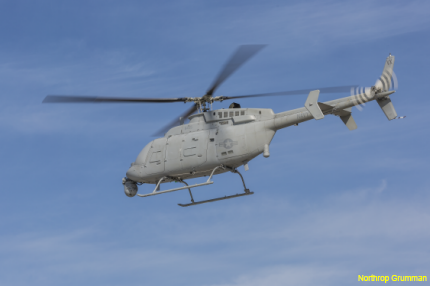Navy's Fire Scout drone copter sets endurance record
The MQ-8C Fire Scout recently showed extended endurance and range for ISR, rescue and other missions.

MQ-8C Fire Scout now has a bigger range for its ISR and other missions.
announcement
The MQ-8C is a larger variant than the MQ-8B. Both are used by the Navy for “reconnaissance, situational awareness, and precision targeting support for ground, air and sea forces.” They can operate from air-capable ships and have been deployed on Guided Missile Frigates and the Littoral Combat Ship. The MQ-8C’s ceiling is 16,000 feet, as opposed to the 12,000-foot limit for the MQ-8B, which also only has half the endurance of its larger variant.
According to Northrop, the recent long-range, long-endurance flight was a portion of capability tests to validate concept operations as well as previously tested performance parameters for the Navy. The draw of such vertical takeoff and landing (VTOL) UASs is that they do not require a runway, unlike similar fixed wing platforms used by the Air Force, Army and Navy for both medium-altitude/long-endurance and high-altitude/long-endurance intelligence, surveillance and reconnaissance missions. As such, they can be used for dropping equipment into hard-to-reach zones as well as extractions and search and rescue missions.
In fact, the Defense Advanced Research Projects Agency has partnered with industry to explore greater possibilities for such VTOL UASs that can be used for multiple mission sets.
“Endurance flights provide a full evaluation of the MQ-8C Fire Scout systems,” Capt. Jeff Dodge, Fire Scout program manager for the Naval Air Systems Command, said. “We can better understand the capability of the system and look at crew tasks and interactions in a controlled environment. This will allow us to adjust operational procedures to maximize the system's effectiveness.”
“Today's MQ-8C Fire Scout performance matches our model exactly,” added George Vardoulakis, Northrop Grumman’s vice president of medium range systems. “With adjustments, our production aircraft will have 12 hours of total endurance on a standard day. This prolonged endurance gives the Navy's commanders a tremendous operational advantage. Increased time-on-station and fewer launch and recovery cycles better enables the Navy's diverse missions.”
According to its manufacturer, the Fire Scout has accumulated over 513 flight hours with 353 sorties.




